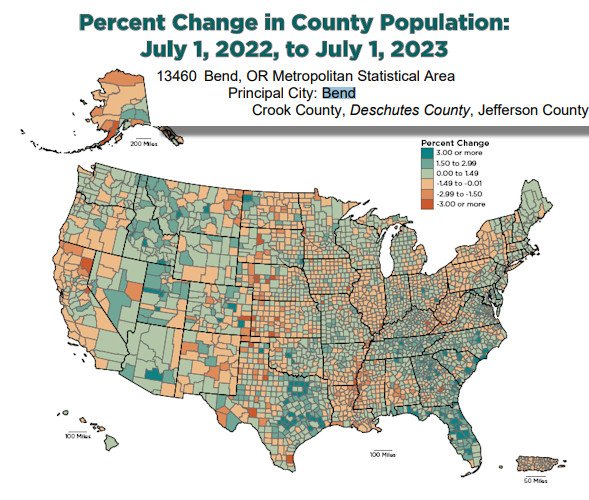Deschutes County again paces Oregon growth, while state drops a bit — and now, all of C.O. lives in the ‘Bend Metro Area’

(Update: Census Bureau Deschutes County estimate lower than PSU's)
While Deschutes added more residents than any other county, it's second in growth rate - to Crook
BEND, Ore. (KTVZ) – Deschutes County, which paced the state as one of the fastest-growing counties in the U.S. for quite a stretch 20 or 30 years ago, is back atop the state’s growth rankings in a year that saw Oregon actually decline in population, the U.S. Census Bureau reported in July 1, 2023 estimates released Wednesday night.
But perhaps the most surprising population-related news was released quietly last summer – not by the Census Bureau, but the Biden administration – and has more to do with where the lines on a map are drawn than where people live. Still, its impact is just now coming fully into light with these new numbers.
For many years – whether most residents knew it or not -- the official Bend “metropolitan statistical area” (MSA) has actually been all of Deschutes County – every bit of it, from Brothers to Sisters, Terrebonne to La Pine. So for all that time, the county’s population was also the Bend “metro area” population, whether in the once-a-decade census or the in-between population estimates.
But while Deschutes County grew by an estimated 2,030 residents in the year ended last July 1 and 10,262 in the years since the April 1, 2020 census, to total 208,513, the official Bend metro area population estimate jumped this year to 260,919 – that’s about 58,000 more than the county’s population.
What gives?
It took a bit of digging, but as it turns out, last July, Shalanda Young, director of the Office of Management and Budget in the Biden administration, issued revised delineations of all 935 metropolitan and “micropolitan” statistical areas in the U.S. and Puerto Rico.
And there, in black and white, on Page 48 of that 183-page document, is the new delineation of the Bend, OR Metropolitan Statistical Area. The “principal city” is still Bend, of course. But the newly drawn metro area now includes ... Deschutes, Crook and Jefferson counties.
Yep, from Madras to Metolius, Prineville to Paulina and all the rest, in the eyes of the federal government, you now live in the “Bend metro area” – like it or not.
Why? Sort of hard to tell. And what does that really change – anything in the way tax or other revenue is distributed, for example? No clear sign of that either, at least not yet.
But that new, more expansive label probably will surprise quite a few folks, many in a position to look into what it really means or changes – while many others are far more likely to just shrug it off and go about their daily business.
It didn't go entirely unnoticed. State Senior Economist Josh Lehner tweeted last July that "the Bend MSA just got 25% larger with the addition of Crook and Jefferson" counties.
But back to the … more traditional look at the figures.
Oregon’s new Census Bureau population estimate for last July is 4,233,358. That means it believes the state lost 6,021 residents.
Now before you go counting outbound U-Hauls, you should know that other newly released figures show a big chunk of that is simple demographics, or in their definition, "Vital Events": Oregon recorded 4,239 more deaths (43,285) than births (39,046) in that year. (Aging baby boomers passing and/or fewer babies born, etc.) The rest, 1,747, is indeed “net migration” – more people leaving the state than arriving.
Also keep in mind that Oregon’s population decline is less dramatic when the 2023 figure is compared to the April 2020 census count, off 3,921 residents. And in both cases, it only represents 0.1 percent of the total.
Still, for a long-time always-growing state, the impacts of the COVID pandemic and other factors are likely playing a role in what at best can be called an end to yearly, seemingly never-ending population growth.
Deschutes County’s gain of 2,030 residents in that last year and 10,262 since April 2020 ranks the county at No. 1 in the state – not the growth rate, which was always the zoom-boom focus before, but in terms of raw numbers.
You can get a major sense why when you look just at Multnomah County, the home to Portland, which the Census Bureau figures lost 4,865 residents in the year and 25,720 residents since April 2020, or 3.2% of its population. Again, the reasons can be calculated and debated, but are tied to demographics, not just politically motivated pointers.
And you might never guess who Deschutes County is No. 2 to, in terms of percentage growth for both the year and decade so far: Neighboring Crook County, which grew by 575 people in the year and 2,214 since the 2020 census, totaling an estimated 26,952 residents as of last July 1. That’s growth of 8.9% in just over three years, compared to Deschutes County's 5.2% and 3.9% for Jefferson County.
Speaking of Jefferson County, it added 130 residents in the last year and 946 residents since 2020, to total 25,454 as of last July.
By the way, this is the yearly second set of population estimates for Oregon cities and counties, as the Portland State University Population Research Center issued theirs late last year, for the same July 1 date.
PSU, for example, said Oregon's 4.29 million population was up a half-percent or so - not down. And for Deschutes County, it estimated 212,141 residents in its certified final Dec. 15 figures (up some 3,000 from the original ones we reported in November, after revisions possibly due to later data from the county) -- and that's 1.7% higher than the Census Bureau's July 1 estimate for the county.
Here's a news release from the Census Bureau on the stats released Wednesday night (midnight ET) - more tables and data will be posted over the next day or so.




